Port Huron to Mac Race
by Norm Astwood
Early last summer I was asked if I had the chance, would I be interested in sailing the Port Huron to Mackinac Race. I thought about it for about five seconds said I would be glad to.
The name of the boat I crewed on is Surface Tension and it is a 36' Nelson/Marek.
It has raced numerous “Hook” Races, Chicago/Mac Races and three Port
Huron/Mac Races. It has won the Hook Race (Racine to Sturgeon Bay around
Door County).
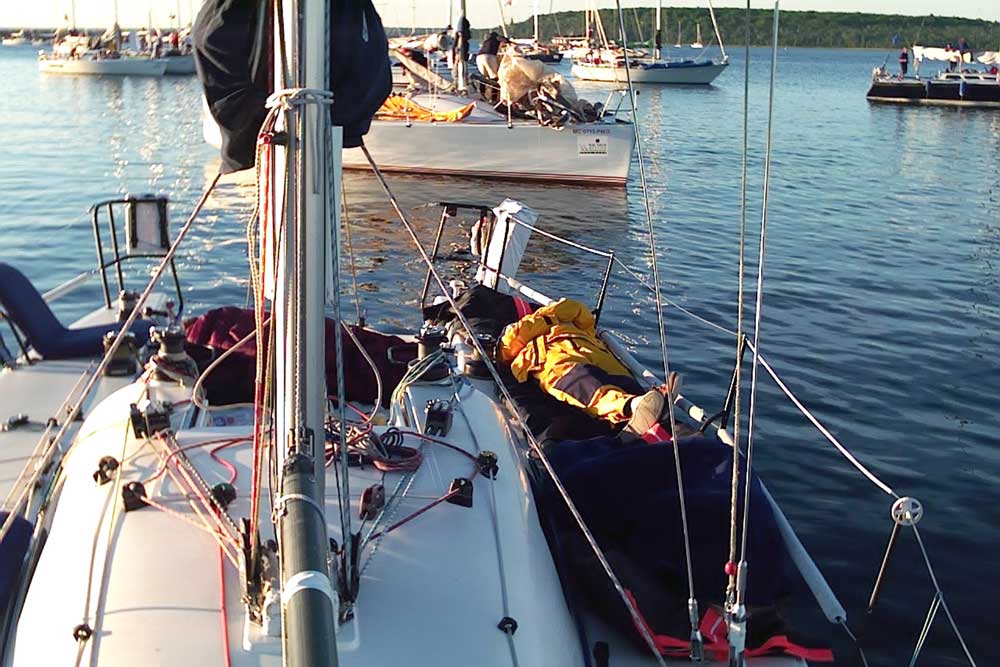 |
| Crew sleeps as harbor fills up. |
I am 58 years old, have been actively sailing in Central Illinois near
Peoria for 11 years, with numerous sailing trips to the Grand Traverse Bay,
Beaver Island, Mackinac area. Although I raced locally, I had no experience
racing on the Great Lakes. I knew that at my age I was lucky to be getting
the chance and it would be stupid not to take it.
I was told we would pick up the boat at Mackinac Island and be part of the crew
to take it down to Port Huron. (The boat was doing the Chicago/Mac the week
before.) The friend that got me my “ride” (Larry Brethorst) would drive with me
to Mackinac City where we would leave the car, catch the boat, and drive back
after the race. Larry gave me a good idea of equipment to take, (inflatable
vest, strobe, tether, etc.), along with clothing suggestions (foul weather gear
and not too much warm or cold weather clothing). The idea is, take everything
you might need, but pack light.
Larry, myself, and Mike Reisinger and Mark Lewis out of Springfield, IL took the
boat from Mackinac City to Port Huron. (Mike and Mark had been part of the crew
that raced the boat in the Chicago-Mac the previous week.) The wind was on the
nose all the way, so we motored for 31 hours straight to Port Huron. I was
surprised how much freighter traffic there was on the lake.
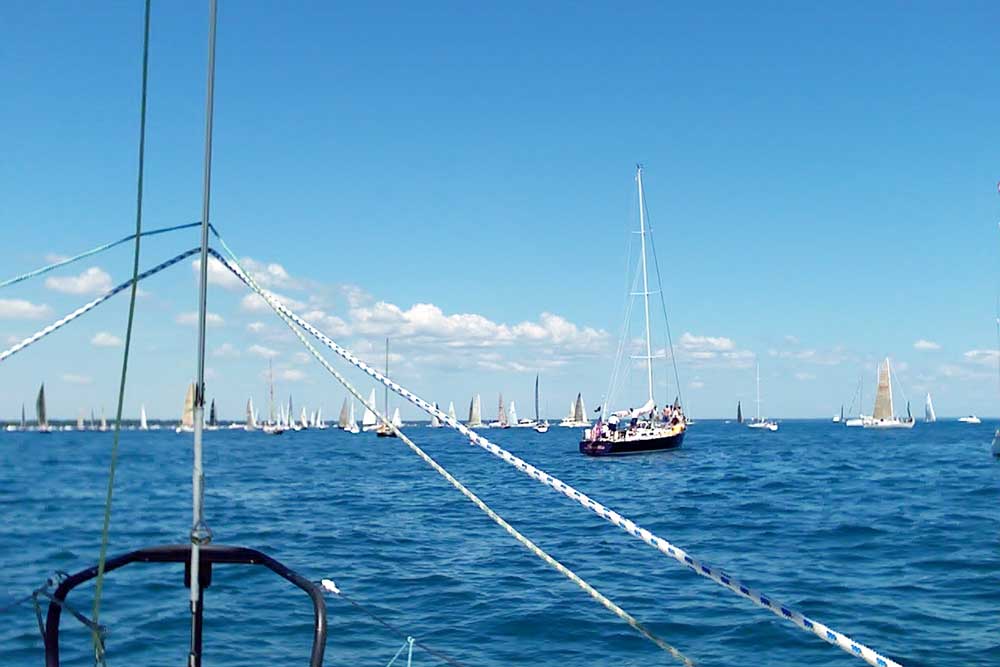 |
| Surface Tension waiting to start. |
We got to Port Huron Thursday afternoon before the race. The race is run
over two courses. There is an inshore course of 204 Miles and the
Southampton Course of 253 miles. (The smaller boats sail the inshore course
that hugs the west side of Lake Huron.) All in all, there were over 250
boats that had to be docked at Port Huron before the race. There was a lot
of rafting up and Port Huron used the few nights before the race for boat
parades and parties. It was a pretty neat deal.
Crew for the race started showing up Thursday evening. I had the chance to meet
them, and knew a few of them. Friday evening the owner of the boat and captain,
Jeff Schaefer showed up. I had met Jeff before when he was racing his Star in
Peoria. Jeff and the Surface Tension are raced out of Racine. We were going to
sail with a crew of eight. Besides Larry, me and Jeff, we had Mike Hettel (who I
knew from my club), Bob Carson from Springfield, IL, Bob Locke from St. Louis,
Judy Cooke from Racine, and Mickey Nielson. Mickey, I also knew (she races Stars
out of Racine and she and her husband Chris are the Quantum Sails dealers in
Racine).
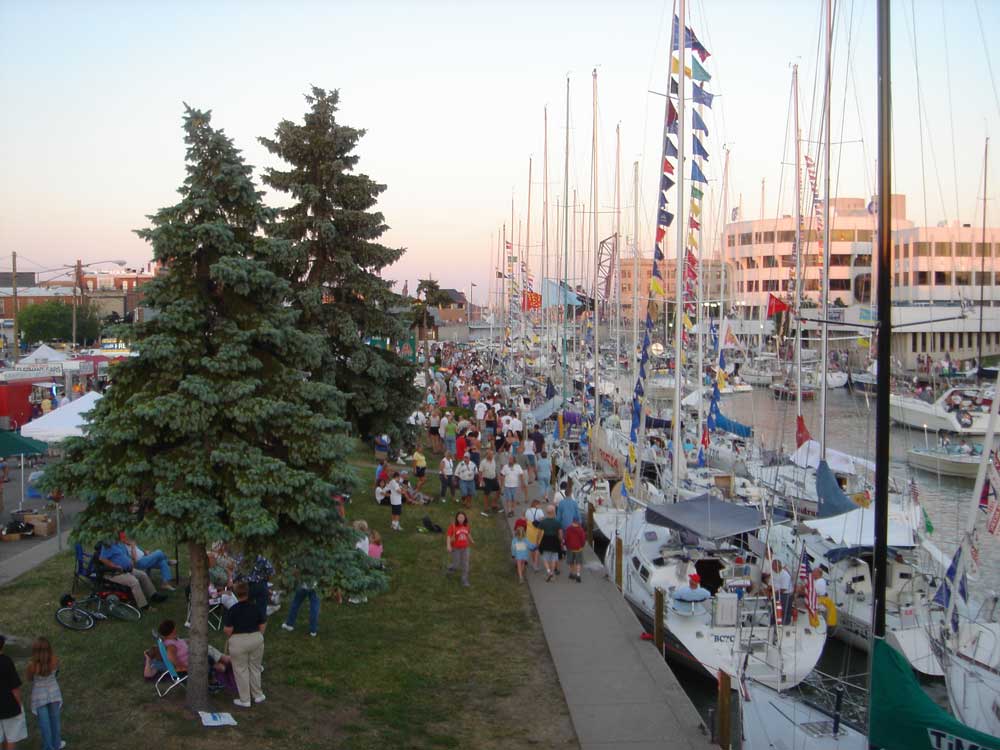 |
| Boats rafted on Black River with carnival and boat parade. |
Saturday morning everyone was anxious to get going, but the fleets start by
class and we weren’t scheduled to start until 1PM. The boats were rafted
along the Black River and in marinas and came down in waves to get to the
start. Since there are drawbridges over the river, they are synchronized
being raised and lowered to move as many boats through as fast as possible.
We finally took off and headed into and up the St.Clair River for the
starting area in southern Lake Huron. Once we got there we found there was a
delay because of lack of wind. After a half hour the wind built enough to
start and before you knew it we were in the countdown and started the race.
The wind was light out of the southeast and we moved out towards the Southampton
light to the northeast. As time moved on Jeff encouraged everyone that could,to
get some sleep to “store it away” for later. (I wish I could have.) Larry, Mike
Hettle and I took the 9PM to Midnight shift as the wind swung towards the south.
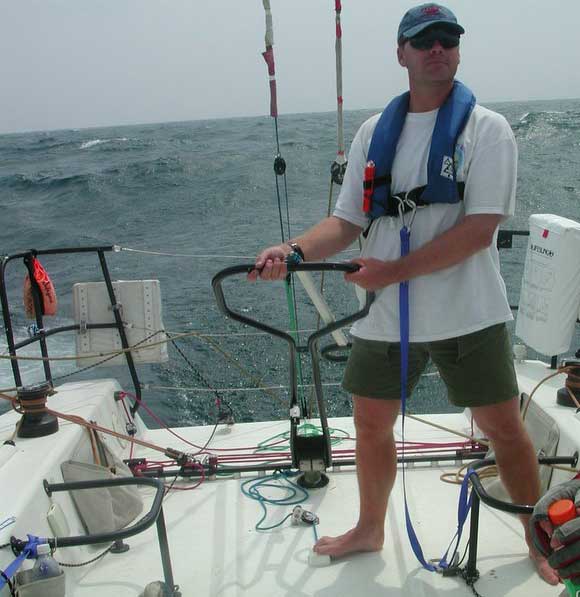 |
| Captain/Owner Jeff Schaefer steering Surface Tension. |
When we came back on at 3AM the wind had freshened (8 to 10 knots) and there
was a full moon low in the sky. I couldn’t believe how beautiful it was and
we could see the running lights of 20 to 30 boats. We were all racing
towards the Southampton light off Ontario where we would go around it and
change course from north north east to the northwest. As the boats converged
on the light we were passing some and some were passing us. We had all the
crew on duty as we went around the light at 4:40 AM and headed towards
Mackinac Island. When we rounded the light (everyone on deck…sail change)
there was one boat 100 yards ahead and two 50-75 yards behind. Incredible!
Then, except for me, Larry and Mike, everyone went to bed.
The wind continued to freshen and we were surfing down waves as the wind
built. When the relief watch came on deck at 6 AM the wind had moved further
to the southwest and strengthened to the point that all extra hands had to
sit on the rail. (So much for off watch sleep!)
On the horizon we could see the USCG boat that was following along with the
fleet. However, behind it we could see storms moving in. As the wind built to 25
to 30 knots the waves grew to 5 to 7 feet. We had taken the spinnaker down and
were flying a jib. Some of the boats in other classes didn’t really have a small
jib and one of them in front of us had its spinnaker tear to shreds from the
high winds. As the storm went on, some of the crew fought sea sickness and
tiredness. But the boat was flying and we were excited as we thought about
finishing the race before midnight.
In the late afternoon the storms blew out and the wind died almost completely.
Our thoughts of an early finish disappeared. The wind freshened enough for us to
move, but it swung around to the northwest directly on our nose. As the sun went
down, most of us were pretty tired from being bounced around in the storm and
lack of sleep. I went down below to the bow and went to sleep on the sails.
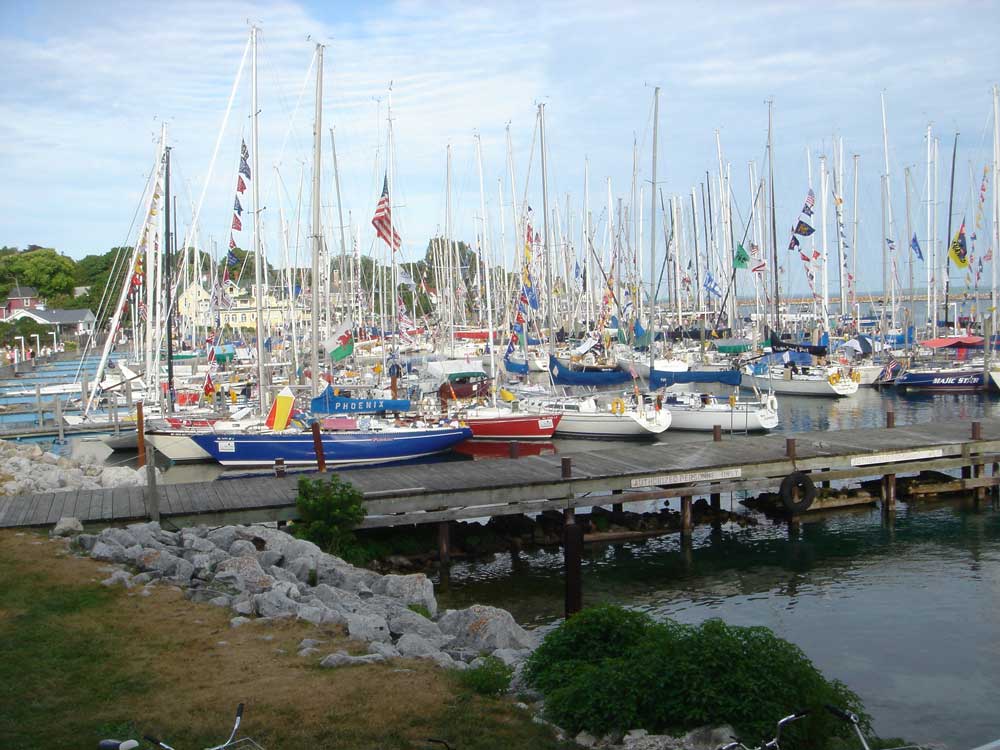 |
| Boats rafted at Mackinac Island Marina. |
I was amazed at how tired you get from riding out a storm, not sleeping and
sparse food. When I came back on deck at midnight I was stiff and sore and
even though it was warm I was cold from fatigue. However, walking the jib
around the mast as we tacked endlessly (it seemed) warmed me up quickly.
One thing I had learned on this trip was that a racing boat has a lot of sail
changes. Every time one comes down, another one goes up. But the sail that comes
down has to be repacked and made ready for next time. Another thing is that the
deck of a racing sailboat is about the most uncomfortable place to be when
trying to rest, even if you are just helping keep the boat balanced by sitting
on the rail. It seems there is always a winch or block sticking into your butt.
(As a personal note- I have run and finished six marathons in my life and this
race was a lot more tiring.)
As we approached the finish line in the latter part of the night there were lots
of boats on the horizon tacking back and forth. We were all headed towards the
straights by Mission Point Resort where the actual finish was. As we neared the
line we lit up the sail with a light so the race committed could also shine a
light on us from a quarter mile away on shore and read our number. They fired a
cannon to acknowledge they had read the number and recorded our finish. In
addition, we read our number and name on the VHF.
There was no dock space available and we anchored. As dawn began to break, we
broke out the rum and had a drink to celebrate. I stayed up for a while just
enjoying the moment as other boats finished and the harbor filled up.
We finally tied up at the Coal Dock at 1 PM. We all got some drinks and had a
crew debriefing as we reviewed things that happened during the race. Later on we
had dinner and then to bed. Bacardi Rum sponsored a great party on the grounds
of Mission Point the next afternoon. Then we ate dinner and the next morning we
took the ferry to the car to drive home while others took the boat back to
Racine.
Reflections: These are the thoughts of only one person and I am sure others in
the crew saw things differently.
We were lucky that it was warm (75-80 degrees air temperature) and that the lake
water was warm (73 degrees). Even though it only took us 37 hours to do the
race, we were darn tired from the storm. If it had been cold we could have been
really miserable.
Jeff Schaefer said he knew we were not a professional racing crew and we would
race the boat as hard as it could be raced safely. I believe Jeff kept his end
of the bargain. I always felt safe on the boat, even though I was sailing in
higher winds and bigger seas than ever before. We were always harnessed on at
night and entirely during the storm during the day. Oh yah, we finished ninth in
our class (out of 13 boats) and 64th of 130 boats on the Southampton course.
The boat: The Nelson/Marek 36 is a racing boat. We carried a couple of
spinnakers and a number of jibs. The boat has running backstays, which means
that every time you tack one backstay has the tension released as the other one
has the tension put on. In addition, even though it is 36' in length it has
tiller steering. Crew accommodations are sparse.
Doing the race was a wonderful experience. Everyone in the crew was fun to be
around and they all were competent and experienced (much more so than me). If
there was one thing I learned it is how tiring it is to do distance racing. It
took me a week to recover from the race. On the other hand, the exhilaration of
being involved in such an event is indescribable. The boats and the lake are
beautiful. Even now, writing about it six months later I get excited. Sailing
over the last 11 years has taken me many places and given me the chance to do a
lot of different things. But, the Port Huron to Mackinac Race was really
special.
If you ever get the chance to do it, take it. I know I’m glad I did. See you out
there.
Norm Astwood has been actively sailing in Central Illinois near Peoria.
All contents are copyright (c) 2006 by
Northern Breezes, Inc. All information contained within is deemed reliable
but carries no guarantees. Reproduction of any part or whole of this
publication in any form by mechanical or electronic means, including
information retrieval is prohibited except by consent of the publisher.